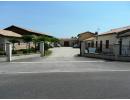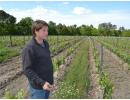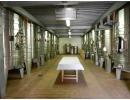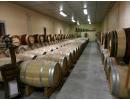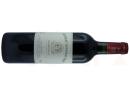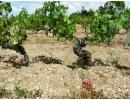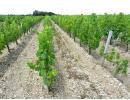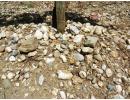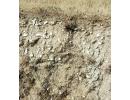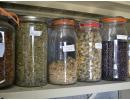Chateau des Graviers
Château des Graviers Cru Artisan - Margaux
The wine's blend prior to 2013 is 70% Cabernet Sauvignon, 20% Merlot and 10% Cabernet Franc. The vines are on average 30 years old producing an average yield of 45 hl/ha, the parcels represent 8.50 ha. After a first sorting in the vineyard, the grapes are sorted again at the cellar then destemmed. Each grape variety will be fermented separately in stainless vats of various sizes depending on the size of the plot. The fermentations last 4 to 5 weeks at 28°C. The wine is aged in french oak barrels for 12 to 16 months with 25% of new oak each year.
PVins notes: Dark red in colour, aromas of reberries and vanilla with a hint of noble oak on the nose. The palate is well-balanced with plenty of well polished tannins, hints of licorice on the long finish, the elegance of Margaux. The wine may be cellared for up to 15+ years depending on the vintage.
Château des Graviers is located in the the southwest of the appellation Margaux in the commune of Arsac. The estate’s name "Graviers" meaning "gravel" derives from the name of the lieu-dit "Le Gravier" where it is located. Obviously the area is rich in gravel which is a good sign for a quality terroir. The château is also located 1.7 kilometre south of the Château du Tertre a 5th Growth estate from the 1855 classification and the only one at Arsac. The family's adventure begins in the 1930s. It is the great-grandfather of Christophe Landry, Marcel Dufourg an employee of Château Cantenac Brown, who was able to gradually buy some promising plots and plant them. Later, the parcels had to be replanted following the severe frost of 1956. In 1995, Christophe Landry took over from his father representing the 4th generation at the château and soon began to develop his style and conception of quality wine by starting the conversion of the estate to organic farming.
The wine is classified as a Cru Artisan since the 2006 classification and one of the only three Crus Artisans of Margaux. The term “Cru Artisan” has been used for more than 150 years in the Médoc region, but only became a structured classification in the 1990's, upon the initiative of the Syndicat des Crus Artisans du Médoc (Médoc Union of Cru Artisan). The “Cru Artisan” classification was officially recognized in 1994 by the European Union. In 2002, French authorities outlined the criteria to be eligible for the classification and in January 2006 forty four wineries were officially listed after a jury tasting. They represent 340 hectares of family owned vineyards in the 8 appellations that make up the Médoc region. Some of the conditions to be classified are: the estate must be a family business, the wine must be estate bottled and wines produced must be tasted and approved by a tasting panel every year.
Château des Graviers covers 13 ha of which 8.5 ha are planted with vines made up of 4 parcels. The historical heart of the estate is located at the lieu-dit "Le Gravier" with 2 parcels near the cellar representing 2.5 ha. Another parcel of about 5 ha is located near the Monbrison area and a newly cleared 4th parcel of about 1 ha is near the "Guiton" area. Château Prieuré Lichine a 4th Growth wine also has parcels in this area.
Christophe and a friend spent every Wednesday for 14 years out in the field studying the geology of the appellation Margaux. He believes that he is probably the only person in Margaux to know in detail the geological structure of the whole appellation. The purpose of this was to better understand the soil structure and to identified which grape variety and rootstock to plant to have the best results. The estate's parcels are mainly composed of Pyrenees gravel dating from the Quaternary era reaching a depth of up to 14 metres providing a good drainage. This is the type of gravelly soil with little clay in the structure on which many of the appellation's Grands Crus Classés have parcels. The topography varies in altitude in the area from 19 to 23 metres and small waterways help to evacuate the water towards the Gironde estuary. The plantation density is 6,600 vines per hectare and the vines have an average age of 30 years old. The grape varieties planted are as follow: Cabernet Sauvignon 61%, Merlot 26%, Cabernet franc 5% and since 2010 some Malbec 3%, Petit Verdot 3% and Carménère 2%. Christophe is looking forward to improving even further the wine's balance, complexity and structure with the last three new varieties planted in the recently cleared new parcel.
Christophe undertook the organic conversion of Château des Graviers when he took over from his father in the mid-90s, the château is now certified since 2010. But in 2009, he was already starting to implement bio-dynamic principals on his 4 parcels with a "parcellaire" or plot by plot approach. Before planting a new parcel he lets the vegetation grow on it for a few years so that natural compost may populate the area for a healthy vineyard. The overall approach is accompanied by planting Sage and Rosemary, for example, these herbs are to provide a bio-dynamic herbal compost to be spread in the parcels. Grass is left to grow free every second row for bio-diversity and natural compost. His dream as a winemaker and becoming his goal, is to apply the concept of terroir in its entirety. As he says "seeing the richness of the parcels, one must be able to produce herbal teas with herbs from the same parcels. Herbal teas are good for humans and so the same applies to vines". This is the reason why Christophe Landry will soon be constructing a building for drying and storing the varieties of flowers and herbs necessary for the preparations. More recently, horses are starting to be used for ploughing the parcels.
The grapes are hand-picked at full maturity. The average yield is 45 hl/ha producing around 40,000 bottles each year. A first sorting will be done on the vines and a second sorting before the grapes are transported to the cellar. The winemaking process is classic for Bordeaux. The grapes are destemmed and each grape variety will be fermented separately in stainless steel vats of various sizes depending on the size of the plot. The Fermentation will last 4 to 5 weeks at 28°c. The ageing will be done in French oak barrels with 25% new each year for a period of 12 to 16 months depending on the vintage.
Links: AOP Margaux - Médoc map - Bordeaux map
MARGAUX
The appellation Margaux created in 1954 is located to the northwest of Bordeaux. It is one of the 6 communal appellations within the Haut-Médoc area situated on the left bank of the Gironde estuary. The appellation has 21 Grand Cru Classé (Growth wines) following the 1855 classification which accounts for 1/3 of the classified estates. Here you will find one of the most prestigious 1st Growth of Bordeaux the famous Château Margaux, it is also the only château to carry the appellation's name in Bordeaux. The vineyards spread over 5 communes which are: Soussans to the north, Margaux in the centre, Cantenac and Labarde to the south and Arsac to the south-west. It is the most southern communal appellation within the Haut Médoc district with Saint Julien, Pauillac and Saint Estephe to its north.
Margaux - 1855 Grand Cru Classé classification:
1st Growth: Château Margaux.
2nd Growth: Château Rauzan-Ségla, Château Rauzan-Gassies, Château Durfort-Vivens, Château Lascombes, Château Brane-Cantenac.
3rd Growth: Château Kirwan, Château d'Issan, Château Giscours, Château Malescot Saint Exupéry, Château Cantenac-Brown, Château Boyd-Cantenac, Château Palmer, Château Desmirail, Château Marquis d'Alesme Becker, Château Ferrière.
4th Growth: Château Pouget, Château Prieuré-Lichine, Château Marquis de Terme.
5th Growth: Château Dauzac, Château du Tertre.
History
Before the Middle Ages, it cannot really be said that there was any vine-growing in the Médoc region. During the early Middle Ages, religious communities and feudal lords started planting vines around the priories (Macau, Cantenac, Vertheuil, the Abbaye de l’Isle) and manor houses (Castelnau, Lesparre, Latour and Blanquefort). These modest micro-vineyards produced new wines called 'Clarets' that were much appreciated by the English. Despite these few vineyards scattered throughout the Médoc, the main vine growing activity was centered in and limited to the southern Médoc, mainly in marshy soils but also in gravel. In the 17th century, Dutch merchants began an ambitious drainage project to convert the marshland into a usable vineyard area. Using technology that was advanced for that time, the Dutch were able to convert enough marshland to allow large estates to form all along the Gironde. Soon the Bordeaux wine regions of Margaux, Saint-Julien, Pauillac and Saint-Estèphe took shape. As of 1720-1730 Margaux started to impose its notoriety. Many Barons, Viscounts, Marques and Dukes serving the French crown before the Révolution and later elected as representative of the Bordeaux Parliament after the Révolution, attached their name to their estate. Some examples are "Bel-Air Marquis d'Alaigre", "Marquis de Terme", "Durfort Conte de Vivens", "Baron de Brane" and "Marquis d'Alesme Becker" to name a few. The region has numerous châteaux with different styles of architecture as the nobles tried to outdo each other, as well as showing off their wealth and success. Before then the estates would usually be named after the area in which they were located. The notion of "château" is recent in Bordeaux, only a hand-full of estate were called “château” in the past, it mainly came in use after the 1855 classification.
Vineyard
The vineyard of the appellation Margaux is the of the communal appellations representing about 1,500 hectares. The majority of the 1855 classified châteaux of Margaux are located in the heart of the appellation on the communes of Margaux and Cantenac. Vines are planted on terroirs that are most favourable to vine growing spreading over 5 communes: Soussans, Margaux, Cantenac, Labarde and Arsac. The appellation stretches about 6 kilometres from north to south and is about 3 kilometres at its widest. The landscape rangers from 10 to 24 metres in altitude. Only red wines are produced, the main grave variety planted is the cabernet Sauvignon followed by Merlot, then in small proportions the Cabernet franc and Petit Verdot. Cabernet Sauvignon is the base for all the wines with the portion of Merlot varying from château to château depending on the style of wine and the château’s terroir. Cabernet Sauvignon is ideally suited to gravely soil, it produces a wine full of finesse with a remarkable bouquet and outstanding cellaring potential. Thanks to its deep roots, it is very resistant to drought, it needs dry, perfectly well drained soils in which it can drive its roots deep down to draw up the necessary nourishment for the production of its tannins. The Merlot brings roundness, fruitiness, freshness and mellowness. Planted in large quantities in the Médoc, it develops particularly well in clayey-limestone and gravely soils. The Cabernet Franc found in smaller proportions generally prefers clayey soils. It brings a light, brilliant colour and a very rich bouquet to the wine. Petit Verdot, with its delicate fragrance of violets, serves to enliven the wines bringing colour, alcohol and a touch of acidity. The wines from the southern part of the appellation(i.e. Cantenac, Arsac and Labarde) tend to be more powerful. There is always an exception to a rule, in this case, a small quantity of white wine is produced in the appellation by Château Margaux, made from Semillon only and sold under the generic appellation of Bordeaux.
The landscape rangers from 10 to 24 metres above sea level. The terroir is mainly made up of alluvial deposits such as gravel (graves garonnaises) and sand set on small hilltops that resemble Islands separated by small valleys, streams and peat swamps. In the heart of the appellation, the plateau on which the communes of Margaux and Cantenac are situated, the soil composition is the richest in gravel, providing good drainage. This is where a large number of the 1855 Grand Cru Classé are located. Margaux is also known to have the thinnest soil of the Médoc with the highest proportion of gravel. The wines of Margaux have a reputation for their elegance and feminity compared to other neighbouring communal appellations such as Saint-Estéphe with its more tannic wines.
Climate
The Médoc peninsula is situated between the Atlantic and the Gironde estuary on the 45th parallel, which partly explains its temperate climate. Relatively warm and humid, with regular sunshine, the Médoc benefits above all from gentle, soft breezes. The relatively strong winds blowing in from the Atlantic are slowed down by a pine forest. The Atlantic winds mingled with those from the estuary creating an excellent circulation of air which protects the vineyards from late spring frosts and diseases. The Atlantic Ocean and estuary both play an important part in regulating the temperature of the peninsula creating a range of climatic variations and different micro-climates. Margaux’s micro-climate is unique as it is influenced by the Atlantic Ocean only 42 kilometres, semi-tropical vegetation such as palm trees, fig trees and banana trees can be found here. Generally speaking, the rain comes between autumn and spring and statistically, it can be said that summers in the Médoc are relatively hot and dry especially when exceptional vintages are produced.



